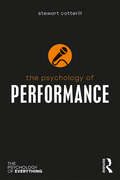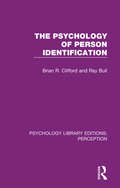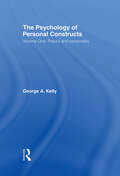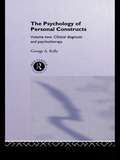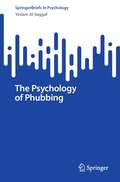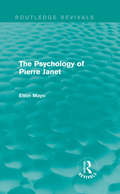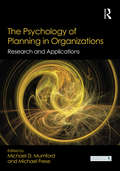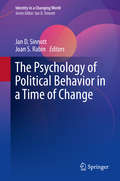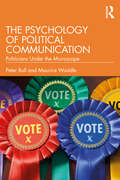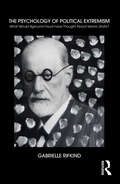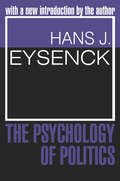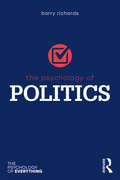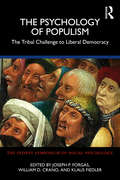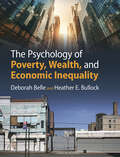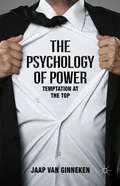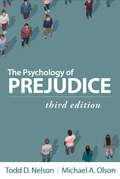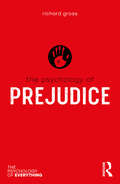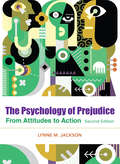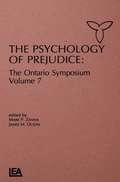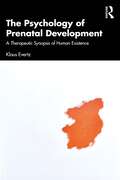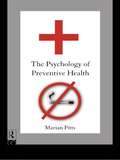- Table View
- List View
The Psychology of Performance (The Psychology of Everything)
by Stewart T. CotterillWhy is performing under pressure often so difficult? What strategies can help us deliver our best performance? How can we boost our self-confidence? The Psychology of Performance explores the key psychological factors that affect our ability to cope under pressure, whether it’s competing in a sport, appearing in front of an audience, or meeting a tight deadline. It looks at how we develop skills through learning and practice, and how self-confidence and decision-making can be sharpened to boost our expertise. The book explains how to develop the best mindset for performance, and shows how factors such as sleep, nutrition, and rest and recovery can influence our moods and how we function. When we need to perform a task with little room for error, The Psychology of Performance helps us to understand how to do this to the best of our ability.
The Psychology of Person Identification (Psychology Library Editions: Perception #6)
by Ray Bull Brian R. CliffordOriginally published in 1978, the laws and procedures governing person identification parades, photofit pictures and the forms of questions asked to obtain a description, had been increasingly called into question. The problem had been highlighted by several well publicised court cases, and considered by the Devlin Committee. This book reviews the status of psychological knowledge at the time concerning the many aspects of person identification and scientifically evaluates the methods and procedures used. Contrary to the popular belief that identification is a simple affair, the authors use the theory and method of psychology to reveal the sources of the difficulties involved in recognising a once-seen person. Estimates of just how good a witness can be are drawn from laboratory studies using face photographs, from mock crime incidents, and from actual criminal cases, for reliability varies markedly in each of these three situations. Both an individual and a social perspective is taken of the eye-witnesses, and research into perception and memory, together with individual differences in such things as cognitive style, personality, suggestibility, age, sex, and ability to form both eidetic and memory images, are examined. The social aspects of stereotypes, the presence of other witnesses and the desire to be a ‘good witness’ are all discussed at length. Finally an extended examination of the possibility of voice parades and changes in identification procedures, together with man-machine interaction techniques, is undertaken.
The Psychology of Personal Constructs: Volume One: Theory and Personality
by George KellyFirst published in 1992. Unavailable for many years this is a reissue of George Kelly's classic work. It is the bible of personal construct psychology written by its founder. The first volume presents the theory of personal construct psychology.
The Psychology of Personal Constructs: Volume Two: Clinical Diagnosis and Psychotherapy
by George KellyFirst published in 1992. Unavailable for many years this is a reissue of George Kelly's classic work. It is the bible of personal construct psychology written by its founder. The second volume presents the implications for clinical practice.
The Psychology of Personality (Psychology Revivals)
by Bernard NotcuttFirst published in 1953, The Psychology of Personality proposes to give an account of the current knowledge about personality at the time; to describe the ideas used by psychologists in this field, the techniques available, the results obtained, and some of their applications. It begins by considering briefly the meaning of the term personality and goes on to explain how this branch of psychology had come to organize itself, and what was its place in the general history of modern thought. Today it can be read in its historical context.This book is a re-issue originally published in 1953. The language used and views portrayed are a reflection of its era and no offence is meant by the Publishers to any reader by this re-publication.
The Psychology of Personhood
by Jack Martin Mark H. BickhardWhat is a person? Surprisingly little attention is given to this question in psychology. For much of the past century, psychology has tended to focus on the systematic study of processes rather than on the persons who enact and embody them. In contrast to the reductionist picture of much mainstream theorising, which construes persons as their mental lives, behaviours or neurophysiological particulars, The Psychology of Personhood presents persons as irreducibly embodied and socially situated beings. Placing the study of persons at the centre of psychology, this book presents novel insights on the typical, everyday actions and experiences of persons in relation to each other and to the broader society and culture. Leading scholars from diverse academic disciplines paint an integrative portrait of the psychological person within evolutionary, historical, cultural, developmental and everyday contexts.
The Psychology of Phubbing (SpringerBriefs in Psychology)
by Yeslam Al-SaggafThis book focuses on the effects of phubbing by parents on their children, partners on their partners, bosses on their employees, friends on their friends, and family members on other family members. Having synthesised the findings from published research about the specific effects on these phubbed individuals in important relationships, the book then presents an exposition of the psychological predictors of phubbing (the triggers), followed by a broader account of the psychological effects of phubbing behaviour. The final chapter looks at the role of social norms in explaining the act of phubbing beyond the individual predictors that trigger the behaviour as it tries to draw a connection between phubbing and social theory.
The Psychology of Pierre Janet (Routledge Revivals)
by Elton MayoPierre Janet (1859 – 1947) is considered to be one of the founders of psychology, and pioneered research in the disciplines of psychology, philosophy and psychotherapy. Janet’s most crucial research, particularly in the subjects of ‘dissociation’ and ‘subconscious’ - terms coined by him - is explored in this book, first published in 1952. As Janet did not publish much in English, these notes provide guidance on such areas of study as hysteria and hypnosis, obsessive thinking and the psychology of adaption. Elton Mayo’s comprehensive collection is an important guide for any student with an interest in the history of psychology, psychopathology and social study, and Janet’s revolutionary work in the field.
The Psychology of Planning in Organizations: Research and Applications (Organization and Management Series)
by Michael D. Mumford Michael FreseThis book examines planning as the critical influence on performance at work and in organizations. Bridging theory and practice, it unites cutting-edge research findings from cognitive science, social psychology, industrial and organizational psychology, strategic management, and entrepreneurship, and describes the practical applications of these research findings for practitioners interested in improving planning performance in organizations.
The Psychology of Political Behavior in a Time of Change (Identity in a Changing World)
by Jan D. Sinnott Joan S. RabinThis volume seeks to add a unique perspective on the complex relationship between psychology and politics, focusing on three analytical points of view: 1) psychology, politics, and complex thought, 2) bio/psycho/social factors of masculinity and power, and 3) underlying factors in political behavior. Contributors examine recent political events worldwide through a psychological lens, using interdisciplinary approaches to seek a deeper understanding of contemporary political ideas, psychologies, and behaviors. Finally, the book offers suggestions for surviving and thriving during rapid political change. Among the topics discussed: Biopsychological factors of political beliefs and behaviorsUnderstanding political polarization through a cognitive lensImpact of psychological processes on voter decision makingMotivations for believing in conspiracy theoriesNonverbal cues in leadershipAuthoritarian responses to social changeThe Psychology of Political Behavior in a Time of Change is a timely and insightful volume for students and researchers in psychology, political science, gender studies, business and marketing, and sociology, as well as those working in applied settings: practitioners, government workers, NGOs, corporate organizations.
The Psychology of Political Communication: Politicians Under the Microscope
by Peter Bull Maurice WaddleContemporary politics is mass-communication politics. Politicians are not only seen and heard, they are seen and heard in close-up through television appearances, speeches, interviews, and on social media. In this book, the authors analyse the ways in which politicians communicate with each other, the media, and the electorate; they also discuss the implications of contemporary political discourse on the democratic process as a whole. Politicians in interviews are typically castigated for their evasiveness. However, microanalytic research shows that there is more to political discourse than this apparent ambiguity. This book reveals how equivocation, interruptions, and personal antagonism can offer valuable insights into a politician’s communicative style. The authors review their empirical research not only on political interviews, but also on speeches, parliamentary debates, and political journalism. Further insights include how political speakers interact with their audiences, how party leaders engage in adversarial discourse at PMQs, and how the spoken messages of politicians can be affected by modern journalistic editing techniques. Thereby, this research generates greater awareness of communicative practices in a diverse range of political contexts. While the interviews and parliamentary debates analysed pertain to UK politics, the speeches also draw on the USA, and European and Far Eastern nations. This engaging book is a fascinating resource for students and academics in psychology, politics, communication, and other related disciplines such as sociology and linguistics. The research is also extremely relevant to policy makers and practitioners in politics and political journalism.
The Psychology of Political Extremism: What Would Sigmund Freud have Thought About Islamic State?
by Gabrielle RifkindRecent terrorist attacks have left the UK (and Europe) genuinely at sea as to how to respond to these distressing events. There are the predictable interpretations with politicians on the right talking about counter-terrorism, harsher punishments and tightening up on the internet, whilst on the political left there is talk about blaming foreign wars. All this analysis is relevant, but insufficient. Politicians are not talking enough about why so many young people are sufficiently angry and alienated that they are prepared to be seduced by the toxic and poisonous ideology of Islamic State. The Psychology of Political Extremism examines both the politics and the psychology, as well as what motivates people to behave in ways that are so disturbing. Freud is the hook as the founding father of the talking cure. A radical and subversive theorist in his time, he claimed that mankind was influenced more by the inner workings of the mind and internal conflicts than by rational thought.
The Psychology of Political Polarization
by Prooijen, Jan-Willem vanThe Psychology of Political Polarization was inspired by the notion that, to understand the momentum of radical political movements, it is important to understand the attitudes of individual citizens who support such movements. Leading political psychologists have contributed to this important book, in which they share their latest ideas about political polarization – a complex phenomenon that cannot be traced back to a single cause, and that is associated with intolerance, overconfidence, and irrational beliefs. The book explores the basis of political polarization as being how citizens think and feel about people with a different worldview, how they perceive minority groups, and how much they trust leaders and experts on pressing societal issues such as climate change, health, international relations, and poverty. The chapters are organized into two sections that examine what psychological processes and what social factors contribute to polarization among regular citizens. The book also describes practical strategies and interventions to depolarize people. The book offers a state-of-the-art introduction to the psychology of political polarization which will appeal to the academic market and political professionals.
The Psychology of Politically Unstable Societies (Global Perspectives in Political Psychology)
by Anna Kende Barbara LášticováThis volume presents the latest developments in the field of political psychology by exploring the psychological processes that underlie political instability and how these can be addressed with psychological interventions. Written by a team of international leading researchers, the book critically re-evaluates the relevance of concepts primarily developed in WEIRD (Western, Educated, Industrialized, Rich and Democratic) contexts, for non-WEIRD societies. It focuses particularly on East-Central Europe and South Africa, showing how they enjoy some privileges of WEIRD countries but are also characterized by a troubled history and relative deprivation. Covering psychological concepts such as political trust, conspiracy thinking, authoritarianism, populism, autochthony, social identity and prejudice, the chapters illustrate that psychology has the tools to explain the recurring and shared problems of these societies. This original book is ideal for scholars and students in social psychology, political science and social science. It will also be useful reading for policy makers, political analysts and anyone who wishes to understand their role in creating more stable and more just societies.
The Psychology of Politics
by Hans J. EysenckIn writing The Psychology of Politics, Hans Eysenck had two aims in mind: to write a book about modern developments in the field of attitude studies which would be intelligible to the layman; and one that would integrate into one consistent theoretical system a large number of contributions on the topic from different fields. Eysenck believes that science has something to say about such problems as anti-Semitism, the origin and growth of fascist and communist ideologies, the causal determinants of voting behavior, the structure of opinions and attitudes, and the relationship between politics and personality. He seeks to rescue these factual findings from the obscurity of technical journals and present them in a more accessible form.The research presented in this book outlines the main principles of organization and structure in the field of attitudes. These principles account in a remarkably complete and detailed manner for the systems of political organization found in Great Britain, that is, the Conservative, Liberal, and Socialist parties, and the communist and fascist groups. Next, Eysenck relates these principles to the system of personality structure which for many years formed the main focus of research activity at the Institute of Psychiatry in London.The Psychology of Politics integrates attitude research with modern learning theory. In his new introduction, Eysenck writes that his research and personal experiences in Germany led him to believe that authoritarianism could appear equally well on the left as on the right. He saw Stalin as equally authoritarian as Hitler, and communism as equally totalitarian as Nazism. The Psychology of Politics contains the evidence and arguments Eysenck used to demonstrate his approach. This volume is of enduring significance for psychologists, political theorists, and historians. It is by indirection a major statement in modern liberalism.
The Psychology of Politics (The Psychology of Everything)
by Barry RichardsHow do some political leaders capture popular support? What is the appeal of belonging to a nation? Can democracy thrive? The Psychology of Politics explores how the emotions which underpin everyday life are also vital in what happens on the political stage. It draws on psychoanalytic ideas to show how fear and passion shape the political sphere in our changing societies and cultures, and examines topical social issues and events including Brexit, the changing nature of democracy, activism, and Trump in America. In a changing global political climate, The Psychology of Politics shows us how we can make sense of what drives human conduct in relation to political ideas and action.
The Psychology of Populism: The Tribal Challenge to Liberal Democracy (Sydney Symposium of Social Psychology)
by Klaus Fiedler William D. Crano Joseph P. ForgasThe recent rise of populist politics represent a major challenge for liberal democracies. This important book explores the psychological reasons for the rise of populism, featuring contributions from leading international researchers in the fields of psychology and political science. Unlike liberal democracy based on the Enlightenment values of individual freedom, autonomy and rationality, both right-wing and left-wing populism offer collectivist, autocratic formulations reminiscent of the evolutionary history and tribal instincts of our species. The book offers a comprehensive overview of the psychology of populism, covering such phenomena as identity seeking, anger and fear, collective narcissism, grievance, norms, perceptions of powerlessness and deprivation, authoritarianism, nationalism, radicalism, propaganda and persuasion, ethnocentrism, xenophobia and the effects of globalization. The book is divided into four parts. Part I deals with the motivational and emotional factors that attract voters to populist causes, and the human needs and values that populist movements satisfy. Part II analyzes the cognitive features of populist appeals, especially their emphasis on simplicity, epistemic certainty and moral absolutism. Part III turns to one of the defining features of populism: its offer of a powerful tribal identity and collectivist ideology that provide meaning and personal significance to its followers. Finally, in Part IV, the propaganda tactics used by populist movements are analysed, including the role of charismatic leadership, authoritarianism, and nationalism and the use of conspiracy narratives and persuasive strategies. This is fascinating reading on a highly topical issue. The book will be of interest to students, researchers, and applied professionals in all areas of psychology and the social sciences as a textbook or reference book, and to anyone interested in the global rise of populism.
The Psychology of Poverty, Wealth, and Economic Inequality
by Heather E. Bullock Deborah BelleEconomic inequality is a defining issue of our time, with a handful of individuals in the United States today owning more wealth than half the population in the country. What are the psychological consequences of living in a profoundly unequal society? This comprehensive textbook is among the first to examine poverty, wealth, and economic inequality from a psychological perspective. Written by two leading scholars in the field, it provides an intersectional analysis of the impact of economic inequality on cognitive, emotional, interpersonal, intergroup, physiological, and health outcomes. Students are introduced to the diverse methods used to study poverty, wealth, and economic inequality and the strengths and weaknesses of various approaches, while the text focuses on solutions at the individual, community, and national levels to restore optimism and encourage action. Chapter features include exercises and reflection questions that help students think critically about the implications of research findings for their own lives.
The Psychology of Power
by Jaap Van GinnekenThe author tests the hypothesis that hubris and the Bathsheba syndrome tend to affect all top leaders, by zooming in on the best known and very highest executives of our own day and age, and examines the psychological forces tugging at the top level of political leadership.
The Psychology of Prejudice
by Todd D. Nelson Michael A. OlsonAddressing core questions about prejudice and stereotyping--their causes, consequences, and how to reduce them--this noted text is now in a thoroughly revised third edition with 50% new material. Written in an engaging, conversational style, the book brings social-psychological theories and research to life with compelling everyday examples. The text explores the personal and societal impacts of different forms of prejudice. Students learn about the cognitive, emotional, motivational, contextual, and personality processes that make stereotyping and prejudice more (or less) likely to occur. The book reviews anti-bias interventions and critically evaluates the evidence for their effectiveness. Every chapter concludes with an instructive glossary and discussion questions. New to This Edition *Full chapter on implicit prejudice. *Chapters on anti-gay and anti-fat prejudice. *New or updated discussions of timely topics: how children develop prejudice, structural racism, benevolent versus hostile sexism, how contact reduces prejudice, and more.
The Psychology of Prejudice (The Psychology of Everything)
by Richard GrossWhy do we develop extreme attitudes to others? Can our personality contribute to our prejudices? How do we reduce prejudice and discrimination? The Psychology of Prejudice explores different forms of prejudice and discrimination, from racial jokes to genocide. It looks at what might cause our prejudiced attitudes, including our personalities, social influences, group identity, and evolutionary factors, and how prejudice can be reduced through education, campaigning, and consciousness raising. Offering insights into a topic of great public concern and debate, The Psychology of Prejudice shows us how we can confront our prejudiced attitudes and contribute to greater tolerance and understanding.
The Psychology of Prejudice: From Attitudes to Social Action
by Lynne M. JacksonThis second edition of Lynne Jackson&’s seminal text presents a significantly updated review of the psychological underpinnings of prejudicial attitudes and behaviors. Given the weaponization of cultural and ideological differences in politics, education, and social media today, the need to understand and fight prejudice is urgent. Jackson synthesizes new research from various areas of psychology to analyze contemporary examples of prejudice, including anti-immigrant policies, police violence against minorities, anti-woman and LGBTQ backlash, and ageist cultural biases. She also explores frequently overlooked issues related to prejudice, such as environmental inequality and speciesism. Drawing from literature in social, developmental, evolutionary, and personality psychology, Jackson explores the environmental and biological roots of prejudice, explaining how societal factors and human predispositions shape how people understand and respond to diversity. She draws connections between prejudice and other social justice issues showing how it is related to greater social problems like inequality and political polarization. She also offers readers a blueprint for overcoming these deeply embedded biases by improving intergroup attitudes and building communities to create progressive social change.
The Psychology of Prejudice: The Ontario Symposium, Volume 7 (Ontario Symposia on Personality and Social Psychology Series #Vol. 7)
by James M. Olson Mark P. ZannaThis volume consists of expanded and updated versions of papers presented at the Seventh Ontario Symposium on Personality and Social Psychology. The series is designed to bring together scholars from across North America who work in the same substantive area, with the goals of identifying common concerns and integrating research findings. The topic of this symposium was the psychology of prejudice and the presentations covered a wide variety of issues. The papers present state-of-the-art research programs addressing prejudice from the point of view of both the bigoted person as well as the victim of bigotry. The chapter authors confront this issue from two major -- and previously separate -- research traditions: the psychology of attitude and intergroup conflict. The chapters are organized in the following sequence of topics: the determinants and consequences of stereotypes, individual differences in prejudicial attitudes, intergroup relations, the responses of victims to prejudice and discrimination, and an integrative summary/commentary. Illustrating both the diversity and vitality of research on the psychology of prejudice, the editors hope that this volume will stimulate further research and theorizing in this area.
The Psychology of Prenatal Development: A Therapeutic Synopsis of Human Existence
by Klaus EvertzThis important book introduces the basics of prenatal psychology and works through the current scientific findings in the psychology and psychosomatics of pregnancy and birth. Through exploring bio-psycho-social relationships, as well as historical and cultural perspectives, this interdisciplinary approach easily breaks down specialist discussions into easy-to-understand concepts.Bridging the gap between foetal programming and psychological research and practice, this accessible book presents the history of the field and the basic concepts of prenatal development before exploring the behavioural dimensions of life before, during, and immediately after birth. Topics include sensory and emotional development in the womb, perception and brain development, the influence of environmental factors and prenatal imprinting and long-term effects. The author also delves into the concept of attachment and support and analyses body symptoms, sensations, feelings and inner images in dreams and imaginations, through the role of art creations and biographical narratives. As a whole, this book provides a therapeutic synopsis of the entire existence, which begins with conception.Explaining how experiences in the prenatal period influence basic psychological imprints across the lifespan, this book is an essential resource for students in a wide range of interrelated disciplines, including developmental psychology, paediatric medicine, neuroscience, infancy and early child development, nursing, social work and early childhood education. It may also be of interest to researchers, clinicians and related professionals.
The Psychology of Preventive Health
by Marian PittsShould I vaccinate my child? Can we stop ourselves getting cancer? How much can I safely drink? These are the everyday questions that health educators and promoters face from the public, but how should they best be answered? From her extensive experience in health psychology Marian Pitts provides an overview of the latest research in the area of preventive health and questions some underlying assumptions in current practice. The Psychology of Preventive Health is written for students and health professionals interested in widening their perspectives on issues concerning primary health care.
